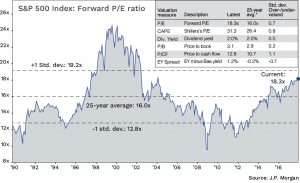Nelson Capital Management


For over a year now, the U.S. markets have continued a steady climb to new highs. In 2017, the S&P 500 was up 21.8% and the Dow Jones rose 28.1%. After declining each of the last two years, international markets produced positive returns in 2017. The international developed markets index (tkr: MXEA) was up 25.7% and the emerging markets index (tkr: MXEF) was up 37.5%.
Broad global economic growth has resulted in increased profits around the world, driving the equity markets higher. In the U.S., the earnings of the S&P 500 constituents grew 12.5% in aggregate, with analysts predicting another double-digit earnings growth year in 2018. Outside the U.S., the results were even more impressive, with international companies from developed nations enjoying profit expansion of 17% in aggregate.
Individual consumer consumption makes up about 2/3 of U.S. Gross Domestic Product (GDP). Despite an economic expansion that has now lasted 102 months, we have worried that most of the consumer base has not been participating in the recovery. Wage growth had remained stubbornly low and a significant portion of the population had not benefited from the recovery in the value of real estate and the stock market.

However, there are increasing indications that a larger percentage of U.S. consumers has begun to benefit from the near decade-long improvement of the U.S. economy. Median wages exceeded 2007 levels for the first time in 2017. Rising wages and low unemployment suggest that employees will have greater bargaining power. The price of oil has remained well below the elevated levels of the early part of the decade and the low interest rate environment has maintained historically cheap borrowing costs. Debt payments as a percentage of disposable personal income are at the lowest level in nearly four decades. These factors will help put more money in U.S. consumers’ pockets. It is no wonder that the consumer confidence level is at a lofty 122.1.
The new tax law will add further stimulus to the economy and could ignite further corporate earnings growth. Investors bought stocks in anticipation of the legislation, which was signed just before Christmas Day, causing an accelerated rise in stock prices through the end of the year. With so many positive fundamentals, what could derail the momentum of the market? Historically, there have been two culprits: investors themselves and the Fed.
Long-time readers of this blog have heard us reference the Sir John Templeton quote that maintains that bull markets “die in euphoria.” In euphoric markets, investors become overly optimistic about future prospects of the market and bid the value up until the price cannot be sustained by fundamentals.

One of the tools to measure valuation is the forward price-to earnings (P/E) ratio. A forward P/E indicates what investors are willing to pay for anticipated future earnings. In the dot-com markets of 2000, investors were paying 27 times anticipated earnings. We all remember how that ended: earnings did not materialize and the lofty valuations came crashing down. There are some signs of euphoric behavior, such as the rapid rise of the “Fab 5” stocks (Alphabet, Amazon, Apple, Facebook and Microsoft) and the wild appreciation of bitcoin. This euphoria has not yet spilled over into the broader stock market, although at 18.3 times anticipated earnings, the S&P 500’s valuation is starting to indicate heightened expectations. We think these expectations are warranted, but disappointment from the corporate sector in 2018 would lead to a market decline.
More likely, the Federal Reserve will throw a wet blanket on this bull market. Why? The Fed’s mandate is to control inflation while stimulating employment. Inflation has remained benign for nearly a decade, partially because wage growth has been muted. The unemployment rate has steadily declined since 2009 from 10% to 4% today. There are emerging signs of labor shortages. For example, the State of Maine cannot find enough snow plow drivers to keep the roads clear this winter.
Tight labor markets produce employer competition for hiring employees. The tax law reduces the tax on corporate earnings from 35% to 21%, which will further stimulate business expansion and hiring. This is the classic cause of accelerating inflation during an economic boom.
Jerome Powell is set to take over as chairman of the Federal Reserve in February of 2018. He is in favor of the current policy of gradually raising interest rates while decreasing the Fed’s balance sheet. This policy will help to offset the inflationary pressures discussed above. To the extent that inflation starts to accelerate, the Fed will increase the frequency and size of interest rate increases and balance sheet reductions. A steady rise in interest rates will increase the cost of debt service after a decade of declines. Reducing the Fed balance sheet further removes money from the economy.
Higher interest rates and tighter monetary policy serve to moderate economic growth, but they also put pressure on stock market valuations. Eventually, the combination produces a recession and bear market. While we believe the stock market rise will continue well into the New Year, eventually, inflation and higher interest rates will derail this bull market. Expanding euphoria and rising inflation will signal the time to become more conservative with both asset allocation and investment selection.
Individual investment positions detailed in this post should not be construed as a recommendation to purchase or sell the security. Past performance is not necessarily a guide to future performance. There are risks involved in investing, including possible loss of principal. This information is provided for informational purposes only and does not constitute a recommendation for any investment strategy, security or product described herein. Employees and/or owners of Nelson Roberts Investment Advisors, LLC may have a position securities mentioned in this post. Please contact us for a complete list of portfolio holdings. For additional information please contact us at 650-322-4000.
Receive our next post in your inbox.